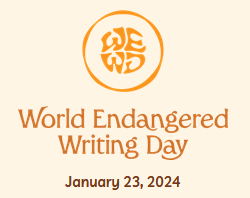Today is World Endangered Writing Day, a day to celebrate the world’s minority and indigenous scripts and communities.

This is an initiative started this year by Tim Brookes, the founder of the Endangered Alphabets Project, who explains:
World Endangered Writing Day was born when I read that in traditional Balinese culture, one day a year was dedicated to respecting and venerating writing.
On the day dedicated to the goddess Saraswati, nothing written may be destroyed, or even a letter crossed out. All the lontar manuscripts—oblong pages of lontar palm leaf, written on with a stylus and then bound between wooden slats—in a household are gathered and act as the representation of the goddess, to whom eighteen offerings are made, one for each of the letters of the Balinese alphabet. Each offering contains the symbol of the supreme god, made of fried rice dough.
This shows a deep understanding of the value and importance of writing, beyond being a mere means of conveying information as quickly and clearly as possible.World Endangered Writing Day, then, is a celebration of writing in all its varied and astonishing manifestations, especially those that see and use writing in far richer ways than we do.
[source]
Throughout the day there are online talks about writing, script extinction and revival, type design, and related topics. You can watch and listen to all the talks on the YouTube Channel: WEWD 2024.
More information about World Endangered Writing Day and about Tim Brookes’ Endangered Alphabets project:
https://www.endangeredwriting.world/
http://endangeredalphabets.com/
https://www.endangeredalphabets.net/
This is what the Balinese alphabet looks like, by the way:

If you want to know more about the world’s writing systems, there’s a little website you might find interesting: Omniglot – the online encyclopedia of writing systems and languages.
I can understand how those who appreciate Endangered Writing Day and the Balinese alphabet might disdain the Latin alphabet, but I am here to sing its praises. I realize that some people have, and still do, view Latin as an instrument of conquerors and colonizers. But I see something else in Latin: Letters that are strong and powerful and clear. They are easy to write and easy to read. It is no accident that the vast majority of languages around the world use Latin. It’s not just a matter of convenience. The Latin alphabet works – and works well – for billions of people. It is better than Greek, much better than Cyrillic, and far superior to ideographic symbols. Using Latin ties us to a very wide part of the earth’s population.
I say, Latin is good thing, not a bad one.
In response to Robert:
I can agree that Latin is a great script, but it has drawbacks of its own
many important sounds do not have letters of their own (sh, ch, ng for example),
and just five vowel letters are too few for many languages, especially in Europe
and South-Eastern Asia.
Cyrillic has letters for sh and ch, but it has the same problem with vowels as Latin
(there are ten vowel letters in Russian Cyrillic, but half of them denote j+vowel),
while the Greek language lacks both sh and ch sounds, and thus have no letters for them (unless the Bactrian Sho is to be counted).
Greek vowels are a mess, there are many vowel letters, but because
of historical sound shifts, they only denote four of the five Latin vowels
(u is written as ou, where the u alone nowadays is pronounced like i).
I don’t think I can find any better natural script than Latin, however
(maybe with Cyrillic as a close second-comer).
I find Cyrillic to be odd, for lack of a better word. It combines Greek, Coptic, Latin and many ‘home-grown’ letters. The result, to me, is a lack of consistency. While it does use some diacritics (primarily Umlaut), its primary means of creating new letters is to morph existing ones into new styles. That results in 6 or 7 different kinds of letters each for ones related to D and L sounds, for instance. Then, they use small capitals for “lower case” on many letters, such as м and М instead of “m” and “M”, while they use Latin style for letters like a/A. Aside from being inconsistent, the small-cap system makes text “dense” and harder to read. A consequence of how Cyrillic evolved is that some smaller language groups are forced to use digraphs and trigraphs, while others have to (somehow) put Latin-type accent marks on Cyrillic base letters, which doesn’t always compose well. Every language group has gone its own way, with no language oversight group enforcing any kind of standardization. So, there are some 130 languages that use Cyrillic, and almost no sharing of keyboard layouts between them. I see all that as a great burden.
In response to Robert’s response to my post:
I completely agree with you on most of what you describe
(which all is true, of course!).
The use of multigraphs in non-Slavic Cyrillic is a nightmare, I totally agree.
Though I actually like Cyrillic for one reason – the use of small ‘capitals’,
and also that it has letters for most of the common sounds,
(it (Russian Cyrillic) lacks j=dzh (exists in Serbian Cyrillic)
and w (exists in Ukrainian))
even those lacking from Latin.